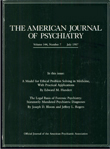Possible Interaction of Clozapine and Lisinopril
To the Editor: Clozapine levels should be at 350–450 ng/ml for clinical efficacy and minimal side effects (1). Factors affecting its metabolism or excretion can influence clinical efficacy. We report on a patient who possibly experienced an interaction effect of clozapine and lisinopril.
Mr. A, a 39-year-old Asian man with treatment-resistant schizophrenia, was receiving 300 mg/day of clozapine; his blood level of the drug was 490 ng/ml. In addition, he had diabetes that was controlled with glipizide, 10 mg/day. One year later, he developed hypertension, so lisinopril treatment, 5 mg/day, was initiated. Shortly afterward, his blood levels of clozapine and one its metabolites, norclozapine, were 966 ng/ml and 512 ng/ml, respectively. Six months later, his dose of lisinopril was increased to 10 mg/day. His blood levels of clozapine and norclozapine, as measured on two consecutive occasions 1 month apart, were 1092 and 380 ng/ml and 1245 and 392 ng/ml, respectively.
Mr. A became more disorganized and had frequent episodes of irritability and angry outbursts. He experienced severe sleep disturbances and frequent nightmares and awakenings. He also salivated excessively. Other known side effects of clozapine, such as anticholinergic toxicity or seizures, were not observed. Laboratory values, including measures of renal functions, were found to be within normal limits.
Mr. A’s clozapine dose was decreased to 200 mg/day. His blood levels, measured after 6 weeks, remained high: clozapine, 1335 ng/ml, and norclozapine, 428 ng/ml. When we suspected a drug interaction, his antihypertensive was changed from lisinopril to diltiazem, 240 mg/day. Repetition of laboratory tests after 6 weeks resulted in clozapine and norclozapine levels that had decreased to 693 and 254 ng/ml, respectively. Although Mr. A continued to experience psychotic symptoms and sialorrhea, his sleep disturbances and irritability had improved.
An interaction in which lisinopril raises the level of clozapine or its metabolites has not been reported, to our knowledge. Angiotensin-converting enzyme inhibitors, by dilating efferent arterioles, decrease overall renal vascular resistance. This in turn decreases intraglomerular pressure, which reduces effective filtration pressure and slows the glomerular filtration rate, causing reversible renal impairment (2). This impairment may not be reflected by routine tests of renal function. Increased levels of norclozapine suggest impaired excretion.
Lisinopril does not influence the cytochrome systems, and it is excreted unchanged in urine. Clozapine is metabolized by cytochrome 1A2 and 3A4 isoenzymes. It is a well-known phenomenon that excess levels of substrates cause abnormal enzymatic feedback control (3). In our patient, levels of both clozapine and norclozapine were elevated. It is not known whether accumulation of clozapine metabolites can cause negative feedback inhibition in the cytochrome P450 system. If so, it can cause an accumulation of the parent compound. The toxic effects of clozapine are known to cause sleep disturbances, with intensification of dream activity and immediate onset of REM sleep.
1. Perry PJ, Miller DD, Arndt SV, Cadoret RJ: Clozapine and norclozapine plasma concentrations and clinical response of treatment-refractory schizophrenic patients. Am J Psychiatry 1991; 148:231–235; erratum, 148:1427Google Scholar
2. Brenner B: The Kidney, 5th ed. Philadelphia, WB Saunders, 1996, pp 1202–1203, 1702–1702Google Scholar
3. Rosenberg LE: Inborn errors of metabolism, in Metabolic Control and Disease. Edited by Bondy PK, Rosenberg LE. Philadelphia, WB Saunders, 1980, pp 73–102Google Scholar



